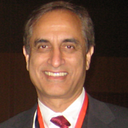Angels dancing on the point of a pin
How many angels can dance on the point of a pin?
I heard a fascinating lecture on this subject in Budapest in 2009, where many astronomers, historians, and scientists had gathered to celebrate the 400th anniversary of the construction of Galileo’s telescope.
The lecture on a topic peripheral to the meeting turned out to be more interesting than the academic discussions on Galileo.
Angels dancing on a pin was not a fringe opinion in the Middle Ages. The most famous theologian and philosopher of the medieval times, Thomas Aquinas, who is still adored by millions, discussed it in his book Summa Theologica (c. 1270). He asked if two angels could be at the same place at the same time.
It remains an important question to millions of modern people. Harold Willmington of Liberty Uuniversity argues that the following questions need urgent investigation (2007):
1. How many of angels can dance on the point of a needle?
2. Could an angel be in two places at the same time?
3. If angels eat, are they able to digest their food?
4. If angels are spirit beings, why do they need wings to fly?
5. Can they fly at the speed of thought?
Aquinas had several dozen propositions on the nature of angels. It seemed a matter worthy of study since the word angel is found some 290 times in the Bible (110 times in the Old Testament, and 180 times in the New Testament).
Within the framework accepted by the scholiasts, the arguments on angels seemed real, and the belief in their number on the point of the pin must have appeared scientific to contemporaries.
The questions Aquinas considered included:
Will there be excrement in paradise?
Will people have hair and nails?
Will the resurrection occur at night-time?
Some historians believe that scholars in Constantinople were debating these questions when the Ottomans laid siege to the city and finally took it in 1453.
Over time, this matter of angels dancing became a metaphor for what was pointless or overly pedantic.
But scholasticism, in one form or the other, lives on in our times.
Many beliefs that we hold dear and consider self-evident may look bizarre to our descendants.
Newton
Isaac Newton spent years doing alchemy and biblical chronology that so shocked other scholars that they hid his work for generations.
Newton believed that the world was going to come to an end in 2016.
He believed he had found a recipe for the philosophers’ stone, a substance that could turn base metals like iron and lead into gold and help humans achieve immortality. He believed that precious metals were produced by spirits in the center of the earth.
The woke world
Millions of wokes believe that one can switch gender at will.
Numerous scientists are saying that defining gender based on genitalia and chromosomes is “inconsistent with science.”
“Antiracism” is an Orwellian phrase whose meaning is the exact opposite of the normal meaning. To be an “antiracist” you must embrace sweeping new forms of racial discrimination.
“Equity”, normally synonym wih fairness or justice, is now used to mean equality of outcomes between different racial groups. Equity seeks to achieve equality of results through discrimination.
More on Judgment Day
Thomas Aquinas was attempting to make sense of the Day of Judgment and to determine what might happen on that day.
In the Islamic tradition, this day arrives only after certain conditions are met. The so-called apocalyptic hadith speaks clearly of the need to kill the Jews for this to happen.
“Allah’s Messenger said, “The Hour will not be established until you fight with the Jews, and the stone behind which a Jew will be hiding will say. ‘O Muslim! There is a Jew hiding behind me, so kill him.’”
(Sahih Bukhari 4:52:177; see also Sahih Bukhari 4:52:176; Sahih Muslim 41:6985)
This most influential hadith is cited in Hamas’s founding charter, article seven. The charter explains that the Egyptian troops who launched the assault on Israel in October 1973 were equipped with “booklets of guidance” including this hadith. Hadiths like this are inspiring the faithful around the world to take matters in their own hands.
Clearly, the conflict in the Middle East is not only about political goals. There will not be peace until Islamic authorities and elites disavow this and other similar hadiths, which has not been done to this day.
